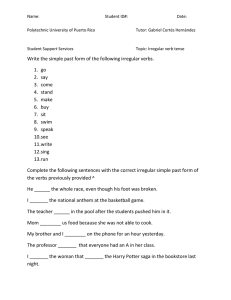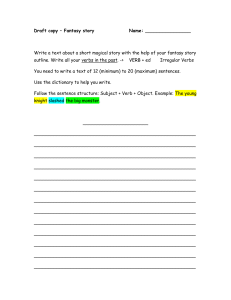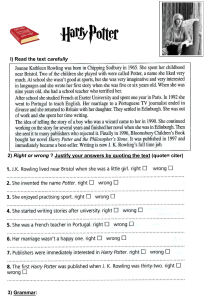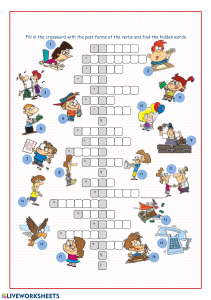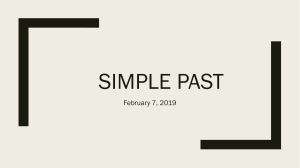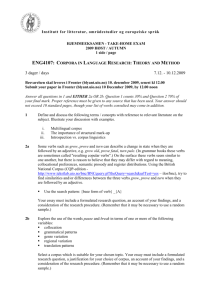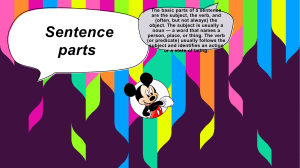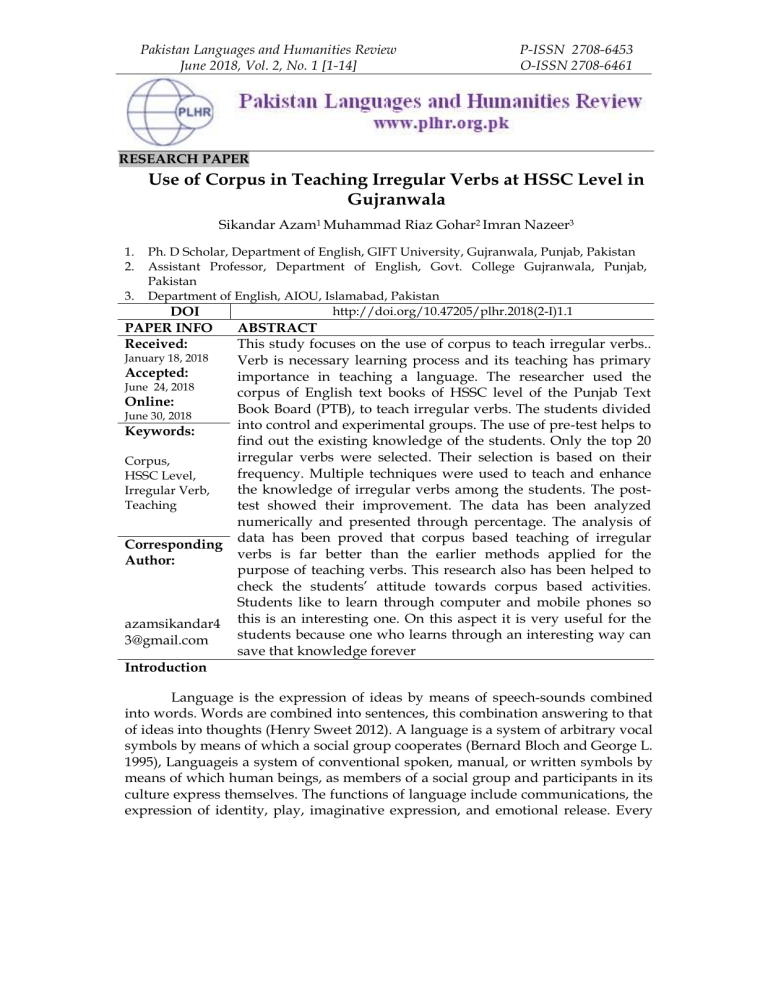
Pakistan Languages and Humanities Review June 2018, Vol. 2, No. 1 [1-14] P-ISSN 2708-6453 O-ISSN 2708-6461 RESEARCH PAPER Use of Corpus in Teaching Irregular Verbs at HSSC Level in Gujranwala Sikandar Azam1 Muhammad Riaz Gohar2 Imran Nazeer3 1. 2. 3. Ph. D Scholar, Department of English, GIFT University, Gujranwala, Punjab, Pakistan Assistant Professor, Department of English, Govt. College Gujranwala, Punjab, Pakistan Department of English, AIOU, Islamabad, Pakistan http://doi.org/10.47205/plhr.2018(2-I)1.1 DOI PAPER INFO Received: January 18, 2018 Accepted: June 24, 2018 Online: June 30, 2018 Keywords: Corpus, HSSC Level, Irregular Verb, Teaching Corresponding Author: azamsikandar4 3@gmail.com Introduction ABSTRACT This study focuses on the use of corpus to teach irregular verbs.. Verb is necessary learning process and its teaching has primary importance in teaching a language. The researcher used the corpus of English text books of HSSC level of the Punjab Text Book Board (PTB), to teach irregular verbs. The students divided into control and experimental groups. The use of pre-test helps to find out the existing knowledge of the students. Only the top 20 irregular verbs were selected. Their selection is based on their frequency. Multiple techniques were used to teach and enhance the knowledge of irregular verbs among the students. The posttest showed their improvement. The data has been analyzed numerically and presented through percentage. The analysis of data has been proved that corpus based teaching of irregular verbs is far better than the earlier methods applied for the purpose of teaching verbs. This research also has been helped to check the students’ attitude towards corpus based activities. Students like to learn through computer and mobile phones so this is an interesting one. On this aspect it is very useful for the students because one who learns through an interesting way can save that knowledge forever Language is the expression of ideas by means of speech-sounds combined into words. Words are combined into sentences, this combination answering to that of ideas into thoughts (Henry Sweet 2012). A language is a system of arbitrary vocal symbols by means of which a social group cooperates (Bernard Bloch and George L. 1995), Languageis a system of conventional spoken, manual, or written symbols by means of which human beings, as members of a social group and participants in its culture express themselves. The functions of language include communications, the expression of identity, play, imaginative expression, and emotional release. Every Use of Corpus in Teaching Irregular Verbs at HSSC Level in Gujranwala physiologically and mentally typical person acquires in childhood the ability to make use, as both sender and receiver, of a system of communication that comprises a circumscribed set of symbols (e.g. sound, gesture, written or typed character).In spoken language, this symbol set consists of noises resulting from movements of certain organs within the throat and mouth. In signed languages, these symbols may be hand or body movements, gestures, or facial expressions. By means of these symbols, people are able to impart information, to express feelings and emotions, to influence the activities of others, and to comport themselves with varying degrees of friendliness or hostility toward persons who makes use of substantially the same set of symbols. Recent changes in education system have increased the importance of teaching English. As the responsibilities of language teachers have risen, they are expected to improve their qualities continuously. This paper aims to display English language teachers’ classroom activities, perception of competence about the activities and professional development needs. Like elsewhere in the world, Turkey has also been trying to upgrade the quality of English language teaching. In this process language teachers play a key role to teach methodology and improve quality of education. They are expected to meet the needs and standards of English as an international language. In this respect (Coskuner 2011) stated that English language teachers should be able to satisfy the expectations of regularly increasing number of students by using up-to-date teaching methodologies performed with dedication and enthusiasm. By considering all these dimensions, Richards & Lockhart (Wichadee, 2011) indicated that language teaching is not universally regarded as a profession that is, having unique characteristics, as requiring specialized skills and training and as being a lifelong and valued career choice.Therefore, designing and developing of authentic material is a major goal of pragmatic inquiry through ELT (Bardovi-Harlig & Mossman, 2016). It is believed that poor quality of English language teaching leads to a lack of sound teacher training and teacher professional development (Vo & Nguyen, 2009). The quality of the learning process is highly affected by teacher effectiveness. Teacher effectiveness has long been discussed and studied in Turkey. In this respect, after taking the viewpoints of 49 higher educational institutions, Turkish Ministry of Education officially accepted the guidelines for general teacher efficacies in 2006, which aimed to be a guide for shaping the entire curriculum by describing teacher effectiveness (Arikan 2010). There is a vital role of English Language in teaching. All subjects are in English language and students need understating of English language to understand those subjects. If students know English language they can understand the lectures delivered by their teachers more effectively. A verb is one of word classes that is in the form of a word or a phrase that expresses an action, an event, or a state of existence. According to the past form of verb there are two kinds of verb, regular and irregular verb. Regular is a form of verb which is being made from present to past by adding “d” or “ed”, and an irregular form is being made from present to past with different additions. To make an irregular verb there is no formula. Those verbs which don’t end on the regular d, ed or ied spelling patterns of past simple or past participle, called irregular verbs. 2 Pakistan Languages and Humanities Review (PLHR) June, 2018 Volume 2, Issue 1 Irregular show its name that their forms are irregular that they will be different from the first. Like go, went and gone. Corpus can be defined as a huge collection of texts of single topic or of multiple topics. A corpus may be in the form of written or spoken data upon which we may make a linguistic evaluation. It delivers data to the ones related to grammarians, lexicographers, and other related fields in order to have better analysis of a language. Computer assisted data in the form of corpora permit linguists to follow the principle of total responsibility, recovering all the occurrences of some specific word or structure for analysis or some arbitrarily collected samples. For learners of English, irregular verbs represent one of the most difficult aspects of the language. They are normally presented in the form of alphabetical lists. Alphabetical lists do not, however, take into account the actual occurrence of these verbs. The richness that authentic texts provide regarding their cultural and linguistic content, having the opportunity while selecting relevant, suitable, and interesting materials for the specific groups of learners, the motivational aspects of learning through authentic materials rather than artificial ones are some of the advantages of using corpora (Mishan, 2004). Irregular verbs haunt the learners of ESL. They are the most difficult aspect of English language. Furthermore, the students take such process of learning a boring one. Students are less interested and more boring. At HSSC level they have the least idea to use computer to enhance their knowledge. In English language there will may be a few sentences verb less, in every sentence we use verb and the verbs are core of English language. In all types of writing as letters, applications, texts we use irregular verbs. The students feel fear to learn the English from beginning to the end. To achieve full mastery seems to be very difficult without learn them by heart. Corpus-based approach for teaching irregular verbs to the students is more effective than traditional approaches of teaching verbs. This research finds out the effectiveness of the usage of corpus-based activities and approaches to enhance the verbs knowledge of the students at HSSC level in the area of Gujranwala, Punjab, Pakistan. Specifically, the aim of this study is to explore the students’ (the experimental group) interest towards corpus and acquired more incidental knowledge of irregular verbs than those who did not participated (the control group). This research also shows the interest of the students toward corpus based learning. The research has been conducted on the students of The Educators College for Boys, G.T. Road, Gujranwala (experimental group). Total 20 students have been selected from HSSC level (10 as control and 10 as experimental group). The students from The Educators College for Girls, G.T. Road, Gujranwala have been taken as sampling (control group). The use of irregular verb and the use of corpus skills have been analyzed. Literature Review In linguistics the corpus is a wide field of study which teaches a representative body of language. In an authentic speech, dialogue, texts, it occurs rather than language. The purpose of the invention of corpus is to illustrate a certain linguistic theory, concepts and ideas (Meyer, 2002; Murphy, 2008). Corpus 3 Use of Corpus in Teaching Irregular Verbs at HSSC Level in Gujranwala linguistics is a procedure that presupposes, it is not only a linguistic field. So, with the help of corpus we investigate the real date instead of artificial one or made-up. It is important to base one’s experiment of language on actual contents. Corpus studies have more characteristics as it comprises on the usage of computer for quantitative evaluation and for qualitative evaluation the techniques of researcher required. So it indulges both. In corpus studies, a wide range of language spectacles including stylistic and historical resolutions, different patterns of discourse, acquiring of language, grammatical constructions and investigation of different kind of vocabulary are used by the learners (Teubert 2005). English language is the language of the English who travelled around the globe and left traces of their culture. The British Empire colonizing the world continents provided one of the major landmarks for the historians, whether political, social or cultural. Therefore, English has been considered as the language of the hegemony spread by the British colonizers mainly in Africa and Asia. (Brutt, Griffler, 2002). Afterwards, it became the language of the American economic power (Rahman, 2004) subsequent to various linguistic, ideological, socio-psychological, pedagogical and socio-cultural implications. Owing to the socio-cultural impact the colonized have developed complex relationship with the language of the colonizers as it has touched their culture, social perceptions and identities. This phenomenon has revealed significant links between language, culture and identity. However, in a present globalized world, English language in an international setting refers to a paradigm for thinking, research and practice in order to establish the position of the English language as a language of intercultural communication (Sharifian, 2009). Communicative language teaching and Grammar Translation Method are the most popular and much practiced methods in ELT in Pakistan (Durrani, 2016). The status of English language in Pakistan has historical and social roots linked with the British rule in the Subcontinent. For that reason, even after the independence of Pakistan in 1947, English language has maintained its role in cultural and socio-political fabric of the region (Kachru, 1986, Baumgardner, 1993, Rahman 1996, Mahboob 2002). Furthermore, in the presence of ethnic diversity along with the various indigenous languages in South Asia in general and Pakistan in particular, language has been viewed as a symbol of identity. As a result, in postcolonial context, English language has been preferred as a neutral language (Mahboob, 2003). Consequently, it gained political acceptance and penetrated in the socio-cultural setting of Pakistan maintaining its position as the language of supremacy (Mahboob, 2003). On the other hand, English language hegemony has been increased by globalization that strengthened the support of Pakistan’s ruling elite towards English language (Rahman, 2004). In order to cope with the emerging trends of globalization, Pakistan’s English-using ruling elite set-up parallel institutes to equip a section of society to excel in an international setting that has started operating increasingly in English (Rahman, 2004). Verbs tell us what the subject of a sentence or clause is doing (or being). Verbs are conjugated according to person, number, gender, tense, aspect, mood, or voice. Verbs are at the heart of sentences and clauses; they are indispensable to the formation of a complete thought. A verb can express a thought by itself (with the subject implied) and be 4 Pakistan Languages and Humanities Review (PLHR) June, 2018 Volume 2, Issue 1 understood. It indicates the simple present, present continuous, simple past, and simple future tenses respectively. Further possible tenses include present perfect (I have taken the bus), present perfect continuous (I have been taking the bus), past continuous (I was taking the bus), past perfect (I had taken the bus), past perfect continuous (I had been taking the bus), future continuous (I will be taking the bus), future perfect (I will have taken the bus), and future perfect continuous (I will have been taking the bus). All the latter uses would require additional grammatical elements to form complete thoughts. To ensure good writing, it is important for verbs to be used consistently and in a logical sequence so that the time period being written about is properly understood. Verbs can also have up to five different forms: root, third-person singular, present participle, past, and past participle. A corpus is defined by McEnery and Wilson (1996:87) as a body of text which is carefully sampled to be maximally representative of a language or language variety‖. This means that any principled collection of recorded instances of spoken or written language can be compiled as a corpus. With the rapid development of computer technology, a number of different types of corpora have been constructed in the form of machine-readable language data (Biber et al., 1998; Gabrielatos, 2005; Sinclair, 1966).Corpus use subsidized language learning and teaching in a number of ways (Aston, 2004; Partington, 1998). Corpora come in many shapes and sizes to serve different purposes. In general, corpora can be classified into two kinds with reference to size and design. A general corpus (e.g. the British National Corpus or BNC) is designed for general descriptive linguistic purposes, so it is usually much larger than a specialized corpus. In contrast, a specialized corpus is designed from particular types of texts for specific research or teaching purposes (e.g. the Cambridge and Nottingham Corpus of Discourse in English (CANCODE), the Michigan Corpus of Academic Spoken English (MICASE)). This study examined the effectiveness of data-driven learning (DDL), explicit instruction and these two methods combined in teaching verb+noun (V+N) collocations to advanced Turkish learners of English. Recognition accuracy of V+N collocations was measured along with participants’ judgment about the acceptability of these collocations. It also explored the opinions of learners about using corpus in learning V+N collocations. Quantitative data were analyzed via a one-way independent analysis of variance and descriptive statistics. Results revealed a statistically significant difference between the three groups in their recognition accuracy of V+N collocations. While the Explicit-Instruction (EI) Group and the Combined (C) Group scored significantly higher than the Data-Driven Learning (D) Group, the means of the EI-Group and C-Group did not significantly differ. With respect to the judgment about the acceptability of V+N collocations, the EI-Group significantly outperformed the D-Group; but the difference between the EI-Group and the C-Group; or between the C-Group and the D-Group was not statistically significant. The questionnaire data showed that the participants found the instruction with the use of corpus more useful and effective for learning V+N collocations than instruction without. For learners of English, irregular verbs represent one of the most difficult aspects of the language. They are normally 5 Use of Corpus in Teaching Irregular Verbs at HSSC Level in Gujranwala presented in the form of alphabetical lists. Alphabetical lists do not, however, take into account the actual occurrence of these verbs. First we make list of verbs through corpus in their order of frequency in authentic English. One machinereadable standard corpus of English, AntConc 3.5.7 is selected to form the basis of this learning list. Then we can learn the students from the verbs used most of the time in the book. The new list ensures that the learner has encountered the most important verbs, no matter when the learning process ends. For the author of teaching materials and the teacher, the new list supplies an empirical basis for the selection and gradation of irregular verbs in language courses. Much research has been conducted and is being conducted in the whole world, but in our area particularly Gujranwala no one is teaching through corpus. Here teachers do not know about this kind of teaching method. That’s why I am going to set a trend to teach through corpus. Teaching and learning process through corpus becomes easier and more interesting both for the teacher and the taught. Material and Methods The research strategy is both as qualitative and quantitative as well. Here the experimental research design has been applied by the researcher. He finds the different results in this research from the students and teachers of The Educators College, Gujranwala. In the most of the institutions of Pakistan the medium of instruction is Urdu. So the researcher has been noted that in Urdu medium institutions, how the teachers teach irregular verbs at intermediate level. In most of the institutions the teachers teach through traditional grammar translation method. So they focus on translation from second language to mother or first language. They teach the students tenses in ESL class. During translation they have been used the verbs so they have been learnt the use of irregular verbs. 20 students were selected as control and experimental group. Mixed ability students were selected through random selection for both control and experimental group. The research was conducted in The Educators College for boys & girls, G.T. Road, Gujranwala. Just 20 students were analyzed as control and experimental group. The students of Intermediate level from ICS group of 2nd year were selected. It is quasi-experimental research, which allows the researcher to evaluate the experimental group of students for pre and post-test conditions. It is known as quasi-experimental research as the selected control group of students has been analyzed before teaching through pre-test and later an experimental group was taught irregular verbs with the help of corpus of Intermediate English to evaluate under post-test conditions. The researcher planned three lessons with the help of corpus from the Intermediate English Text Books. They were taught with the help of corpus six weeks. Later, post-test results were recorded to assess the improvement in the use of irregular verbs of students. The difference of both the tests have been compared, evaluated and analyzed to lead the discussion of experiments to final success. Results and Discussion 6 Pakistan Languages and Humanities Review (PLHR) June, 2018 Volume 2, Issue 1 This chapter investigates the data compiled by researcher. The research involved quantitative data. The data has been obtained from the mean of students’ score taking test. The test given to the students was comprised on multiple questioners, three types were there. First the researcher took a pre-test from the 10 students of Intermediate level ICS group class, 2nd year. There were mixed ability students in the class of ICS 2nd Year. Whole of the students tried their best to tackle the test but due to shortage of knowledge they didn’t get better marks. They were unaware of irregular verbs but they know about the verb. Some of the students got good marks and some of them were got very poor. In the pre-test result the highest percentage was 73.33 and the lowest was 13.33 so the average of the complete result was 44%. This figure was very low as the 3rd division. The students were needed to learn and teach them the use of irregular verbs and enhance the knowledge of forms as well. One can never compete who don’t know the forms of verb. Forms are very important to write a paragraph even a sentence. So they were needed to study. They wanted to learn the verbs as well. There was also need to develop some interest among the students to make sentences and to write something creative. In the teaching phase, first of all, the researcher made lesson plans to teach the experimental group. The researcher made three different lesson plans for six weeks’ treatment of the students. The lesson plans were comprised on sentence making, use of verb and the use of irregular verbs respectively. The four books of intermediate level were used to teach the students. The students were taught in a different way as compare to a traditional way of teaching. First the students were told about corpus. How can we make the corpus and the use of corpus? The software AntConc. 3.5.7.0. was also introduced and drilled by the students on it. They did not know about this software. The students were asked to open the words list in AntConc and there they have to find irregular verbs. They feel some hurdle but found the following list of irregular verbs. Students were just told about the irregular verbs and drilled them accordingly. So they were able to find the irregular verbs from the corpus of Intermediate books. The given below list of irregular verbs was made by the students by using corpus. In the Table-I the frequency tells that how many times the particular verb is used in the four books of intermediate. The rank shows the serial number of the particular word in the word list of AntConc software. Sr. No. 1. 2. 3. 4. 5. 6. 7. Irregular Verb Be said Do Could Know See Get Table 1 List of Irregular Verbs Sr. Irregular Frequency Rank No. Verb 395 26 21. Keep 290 39 22. Set 231 49 .23. Read 170 66 24. Sat 143 76 25. Brought 116 95 26. Stopped 109 99 27. Leave 7 Frequency Rank 31 31 30 26 25 23 22 329 336 345 395 405 441 452 Use of Corpus in Teaching Irregular Verbs at HSSC Level in Gujranwala 8. 9. 10. 11. 12. 13. 14. 15. 16. 17. 18. 19. 20. Come Go Think Made Take Began Tell Felt Give Won Find Became Heard 100 98 97 90 71 61 51 40 40 38 35 34 34 107 109 112 124 156 181 208 260 261 274 295 302 307 28. 29. 30. 31. 32. 33. 34. 35. 36. 37. 38. 39. 40. Lost Hold Stood Cut Try Carried Born Lay Met Ran Buy Ring Sent 22 21 21 19 19 18 17 17 16 16 15 15 14 453 465 476 502 525 534 556 572 597 603 616 642 683 In the Figure-I an irregular verb be is encircled. The frequency of the word is 395 and the rank is 26. It shows that the word be is used 395 times in the four books of Intermediate level English. The rank 26 shows that 26 is the serial number of the word be in the list of corpus of the software AntConc 3.5.7.0. 8 Pakistan Languages and Humanities Review (PLHR) June, 2018 Volume 2, Issue 1 Figure 1 In the teaching phase the researcher taught the students how can they use the verb in their own sentences. Here the researcher used 16 to 25 ten irregular verbs to teach and drill the use of verb in their own sentences. We can see in FigureII, in this figure word met is used in different sentences. It shows that what kind of words used with the word met as red, green and purple colored words are there to show the words used with find. With the help of lesson plans the researcher just focused on irregular verbs. The students were taught next 26 to 40 irregular verbs with their simple past and past participle forms. They were asked to use these irregular verbs in a paragraph as they can write an essay or whatever they want to write. They were asked to use the next two forms in their paragraph as well. The students were taught with the help of audio visual aids as the computer was there and they by-self found the list of irregular verbs. So the computer was used as visual aids and they were also asked to work in group and pair. They did it in well. The researcher gave the students free hand to write on any topic for better results. 9 Use of Corpus in Teaching Irregular Verbs at HSSC Level in Gujranwala Different kind of writings was written by the students and they did it in well and good. The researcher moreover taught the students with the help of other irregular verbs given in the Table-I as there is same that the word ran is used how much times and what is the use of the irregular verb ran. Its forms were also discussed as ran is the 2nd form used as simple past and run is its base form which is infinitive, this form is used as past participle as well because it is the third form is as well. The researcher same as taught the students next irregular verbs. Given below figure shows that what kind of words use with the word met, here met is irregular verb. Figure 2 After teaching the experimental group, a post-test was conducted from the students. The students showed good results after learning the irregular verbs and the forms of irregular verbs. They used the irregular verbs in a good way. They used appropriate words in their writings as well. The post-test was comprised on different types of questioners. Three types of questioner were made to conduct the post-test. The post-test was same as the pre-test but the material was completely different from the pre-test. The students tried their best to attempt all the questions. All the students attempted all the questions. They showed good grades after learning irregular verbs. Following table-II shows the difference between the pre and post-test taken by the experimental group. Students showed 43 percent better performance in the post-test as compare to pre-test. This performance is due to effective teaching method and the use of visual aids with different kind of activities. The students were learned irregular verbs with the use of different gadgets as AntConc and Corpus of Intermediate four books. Tests were taken again and again. Researcher taught them irregular verbs very effectively. Table 2 Pre and Post Test Difference 10 Pakistan Languages and Humanities Review (PLHR) Sr. No. 1. 2. 3. 4. 5. 6. 7. 8. 9. 10. Pre Test %age Post Test %age 56.67 90.00 40.00 73.33 56.67 90.00 73.33 100.00 43.33 86.67 20.00 73.33 13.33 73.33 40.00 90.00 43.33 96.67 53.33 96.67 Overall Percentage June, 2018 Volume 2, Issue 1 Difference 33.33 33.33 33.33 26.67 43.34 53.33 60.00 50.00 53.34 43.34 43.00% The researcher first got preparation to teach at Intermediate level. A pre-test was made. Then the pre-test was conducted and check all the tests carefully. The irregular verbs knowledge was targeted in the test. The students showed 44% results in their pre-test. In the test researcher find different errors. They did not know the forms of irregular verbs. They used ed to make the forms of irregular verbs. They did not know how to use the verbs in their own sentences; even they were unable to write a correct sentence. The researcher then made lesson plans. The lesson plans were planned according to the students’ level of learning and their errors to be removed. The irregular verbs knowledge as well as sentence making and tenses were targeted in the lesson plans. They were taught 1.5 month (six weeks). After the end of sixth week a post-test was conducted. The students showed 87% result. A big change was noted after the teaching of just six weeks. The students showed 43% improvement in their knowledge of irregular verbs. They were much unaware of corpus as well. They were learnt how to use corpus to enhance their knowledge and most important than how can they use these techniques/skills to enhance other knowledge of vocabulary, noun, adverbs etc. The post-test showed that the students did completely understand the lectures with the help of corpus and enhanced their knowledge of irregular verbs. Conclusion The results of the students’ irregular verbs knowledge conclude that the students got improved in the post test and the pre-test result of control group was 44% and the result of experimental group after the teaching phase was 87%. A big change was noted in the results. So the use of corpus to teach irregular verbs is very helpful and useful for the students. The results also conclude that the students showed better performance with the use of corpus. They showed their interest towards the usage of corpus. They were very enthusiastic to use computer. This is the era of computer so the teaching should be through computer. For effective results the teaching through computer is very necessary. However, again, future 11 Use of Corpus in Teaching Irregular Verbs at HSSC Level in Gujranwala research will need to verify if this is indeed a favorable condition for language acquisition, and if the meaning students report finding in the data actually helps them to use the irregular verbs in their writings. Students showed good result after the learning of six weeks. The main goal of this corpus based study was to examine if the effective use of corpus in teaching irregular verbs. So the results proved that the corpus based teaching is very helpful to enhance the knowledge of irregular verbs of the students at Intermediate level. This research was made in Gujranwala and it is proved that teaching with the help of corpus improves the irregular verbs of knowledge of the students. The students also found enthusiastic toward corpus based teaching. Both of the objectives are achieved. 12 Pakistan Languages and Humanities Review (PLHR) June, 2018 Volume 2, Issue 1 References Aston, G., Bernardini, S., & Stewart, D. (Eds.). (2004). Corpora and language learners .(17). Amsterdam: John Benjamins Publishing Bardovi-Harlig, K., & Mossman, S. (2016). Corpus-based materials development for teaching and learning pragmatic routines. In Tomlinson, B. (Ed.) SLA research and materials development for language learning (pp. 250-278). London: Routledge. Baumgardner, R. J. (1993). The English Language in Pakistan. Oxford UniversityPress, USA. Biber, D., Conrad, S., & Reppen, R. (1998). Corpus linguistics: investigatinglanguage structure and use. Cambridge: Cambridge University Press. Bloch, B. George, L. (1995). Outline of Linguistics Analysis, Journal Language, Vol.31, No. 2 pp. 312-345. Brutt-Griffler, J. (2002). World English: A study of its development (Vol. 34). Multilingual Matters. Coskuner, O. (2011). Psychology of gender through the lens of culture, SpringerJournal Durrani, H. (2016). Attitudes of undergraduates towards grammar translation method and communicative language teaching in EFL context: A case study of SBK women’s university Quetta, Pakistan. Advances in Language and Literary Studies, 7(4), 167-172. Gabrielatos, C. (2005). Corpora and language teaching: just a fling or wedding bells?TESL-EJ, 8(4), 1-35. Kachru, B. B. (1986). The power and politics of English. World Englishes, 5(2‐3),121140. Mahboob, A. (2003). The English language in Pakistan: ofits history and linguistics. Pakistan Journal of Language, 4(1) McEnery, T., & Wilson, EdinburghUniversity Press. A. (1996). Corpus A brief overview Linguistics. Edinburgh: Meyer, B. F. (2002). The Aims of Jesus, (London: SCM Press). Mishan, F. (2004). Authenticating corpora for language learning: a problem and itsresolution. ELT Journal, 58 (3), 219-227. Murphy, C. M. (2008). Wealth in the dead sea scrolls and in the Qumran community(STDJ 40; Leiden/Boston: Brill). 13 Use of Corpus in Teaching Irregular Verbs at HSSC Level in Gujranwala Partington, A. (1998). Patterns and meanings: Using corpora for English language research and teaching (Vol. 2). Amsterdam: John Benjamin Publishing. Rahman, T. (1996). British language policies and India. LanguageProblems and Language Planning, 20(2), 91-115. imperialism in Rahman, T. (2004). Denizens of alien worlds: A survey of students and teachers atPakistan's Urdu and English language-medium schools, and adrassas. Contemporary South Asia, 13(3), 307-326. Sarac HS, Arikan A 2010. Application of a checklist to assess the place of target culture in foreign language course books. Hitit University Journal of Instituteof Social Sciences, 3(1/2): 45-56. Sharifian, F. (Ed.). (2009). English as an international language: Perspectives and pedagogical issues (Vol. 11). Multilingual Matters. Sinclair, J. (1966).‘Beginning the Study of Lexis’, in C. E. Bazell, J. C. Catford, M. Sweet, H. (2012). Historical language,language Paper. attitudes towards language, Characteristics of Teubert, W. (2005). ‘My Version of Corpus Linguistics’, International Journal of Corpus Linguistics 10: 1–13. SUSAN HUNSTON 166. Vo & Nguyen, (2009). Managerial Ownership, Leverage and Dividend Policies:Empirical Evidence from Vietnam’s Listed Firms, International Journal of Economic & Finance, Vol. 6, No. 5. Wichadee, S. (2011). The effects of metacognitive strategy instruction on EFL ThaiStudents Reading Comprehension Ability, Journal of college teaching and learning, Vol. 8 No. 5. 14
